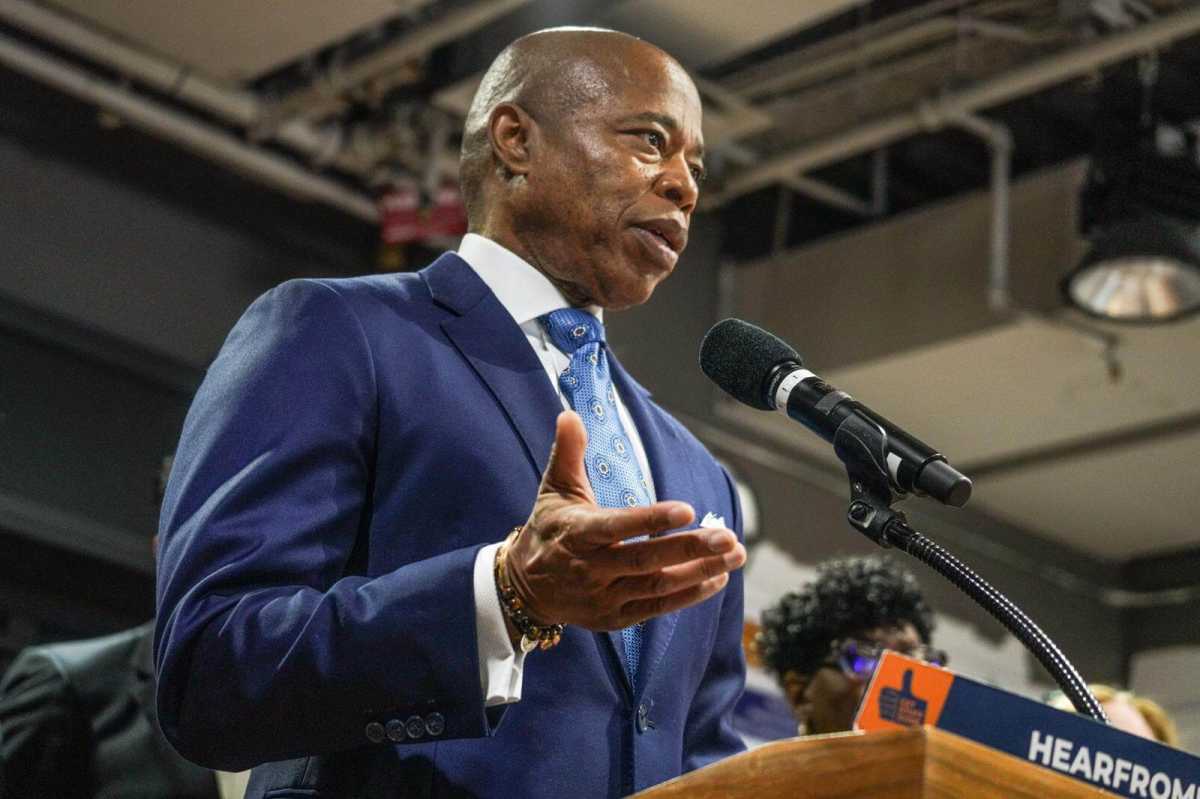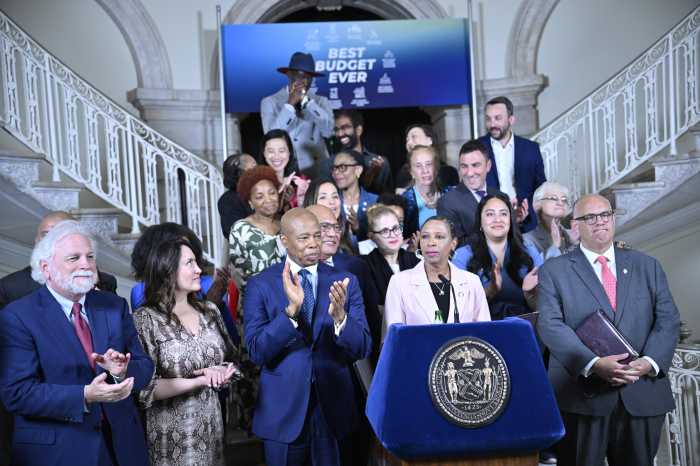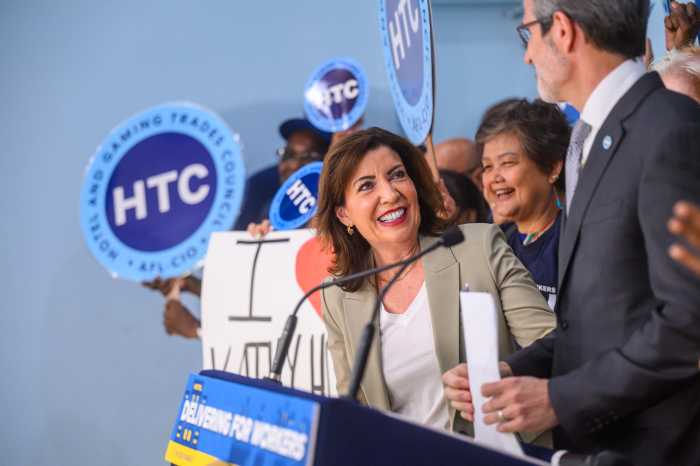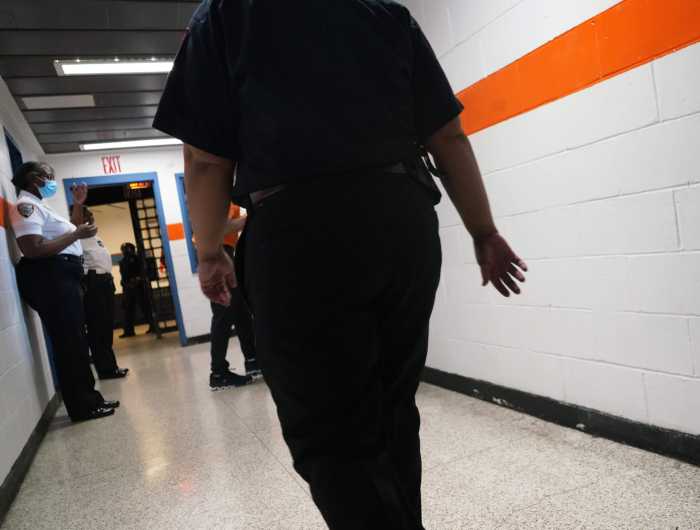Nearly half of the city’s available hotel rooms are currently occupied by asylum seekers and there are few rooms left to accommodate an expected surge in migrants following the expiration of Title 42 last week, Mayor Eric Adams claimed Wednesday.
But City Hall and the mayor himself quickly revised that claim.
Adams made the remarks in response to a reporter’s question about why his administration has moved toward housing migrants in school gymnasiums and other congregate settings instead of hotels over the past week, following an unrelated press conference. The city has used hotels as emergency shelter sites for housing a portion of the 67,000 mostly Latin American migrants who’ve flooded into the city since last year.
The mayor suggested that so many of the city’s hotel rooms being taken up by asylum seekers is having a negative impact on the city’s tourism industry — one its main economic drivers.
“New York City is the hotel capital. We’re the hotel capital,” the mayor told reporters. “Tourism, visitors, sporting events, graduations, people come to town because their loved ones are graduating. We’re the hotel capital and it’s a major economic engine for us. Almost 50% of those hotel rooms, they’re taken up by migrant asylum seekers that we’re paying. So instead of money coming from people who are visiting us and spending and our tourism and our Broadway plays, instead of them using those hotels. We’re using those hotels.”
City Hall, however, modified these numbers on Thursday. It said the 50% was of hotel rooms deemed suitable for migrants. Then, on the MSNBC show Morning Joe, the mayor said he meant 40% of hotels that can handle migrants.
Hotels make up many of the city’s 150 emergency shelters as well as its eight Humanitarian Emergency Response and Relief Centers (HERRCs). In addition, the Roosevelt Hotel in Midtown Manhattan was just converted into the administration’s new dedicated asylum seeker arrival center, which will serve as the first destination for incoming migrants, connecting them to city services and offering beds for an overnight stay.
But City Council Deputy Speaker Diana Ayala told the New York Daily News, in a report, that the mayor’s contention is “impossible” because the city has roughly 130,000 hotel rooms and 41,000 migrants in its care. Plus, a portion of those migrants are housed in other types of facilities like the city’s homeless shelter system.
The mayor also said the city is also running low on hotels that are willing to accept asylum seekers, charging prices the city can afford or have the proper facilities to accommodate them.
“We reached out to our hotels, many of them are saying, ‘we don’t want to get into the shelter business,” he said. “Many of them are going to price points that is just too high for taxpayers to pay. Many of them are not suitable for housing migrants.”
During a separate briefing focused on the migrant influx Wednesday afternoon, Deputy Mayor for Health and Human Services Anne Williams-Isom — who has led the city’s response to the crisis — said that while hotels haven’t been ruled out as an option for sheltering migrants, there aren’t many left the city can use.
“I wouldn’t say that hotels are no longer an option,” Williams-Isom said. “I would say that we don’t have many more hotels to go into.”
Hotel Association of NYC President Vijay Dandapani, in a statement to amNewYork Metro, didn’t speak to the mayor’s claim that migrants are taking up nearly half of the city’s hotel rooms, but rather that the industry can both assist with the crisis and still serve the city’s visitors.
“The hotel industry is focused on its primary mission: Serving those who visit New York City for business and to enjoy our city,” Dandapani said. “We are confident that — even as we help the city navigate this challenge — we will continue to serve visitors to New York and support the local economy as a critical industry.”
Following the expiration of Title 42 — a public health rule used during the pandemic to lessen immigration into the country — last Thursday, Adams’ office has scrambled to find additional housing for what it expects will be a major uptick in the number of migrants coming here each day. Williams-Isom said the city is already starting to see that increase with 4,300 asylum seekers showing up in the Big Apple over the past week, and the number of daily arrivals increasing from between 200 and 300 to between 600 and 700.
The mayor passed executive orders relaxing parts of the city’s right to shelter law, to allow families to be placed in congregate settings, and to allow City Hall to circumvent the standard land use process for siting, building and leasing homeless shelters. His administration has also pursued sending newcomers to upstate municipalities, including Orange and Rockland Counties, but has been met with significant backlash from local officials in those areas.
Williams-Isom said the city is at a “breaking point’ and that all options are “on the table” in its efforts to handle the influx.
“We are putting all options on the table and we are going to look at everything and make the best decisions that we can for the families and children and individuals that we have housed already and for the New Yorkers that are here,” she said.
This story was updated at 9:50 a.m. May 18
































